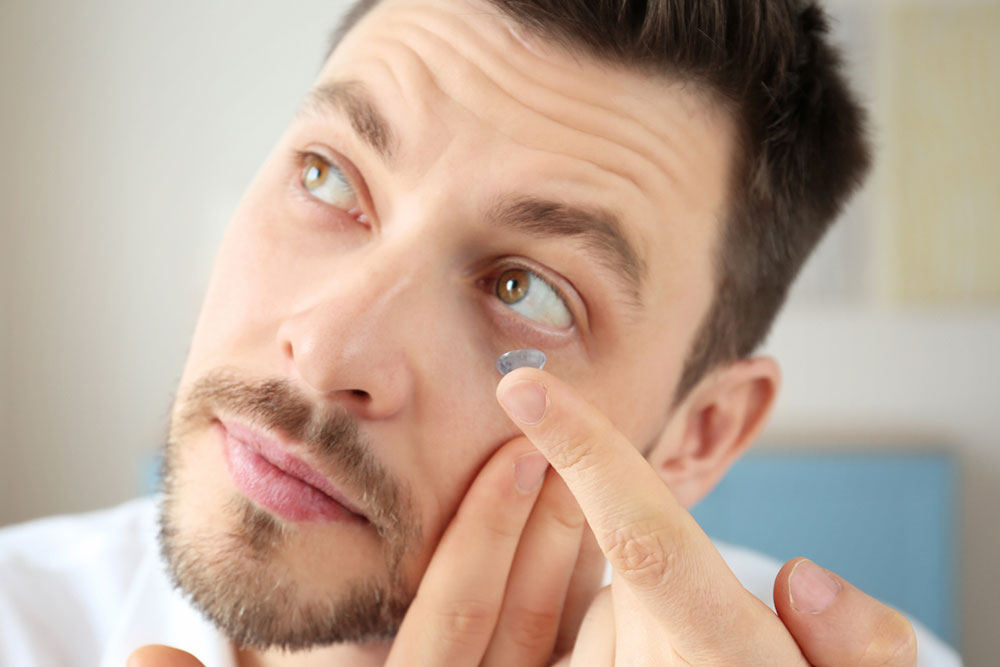6 contact lens mistakes and how to avoid them

If one wears contact lenses, either regularly or occasionally, they should adopt certain habits to maintain good eye health. This is because research suggests that those who use contact lenses frequently are at a higher risk of eye conditions like dry eyes. Further, improper handling or use of lenses can increase the risk of eye infections. So, to keep such issues at bay, one must avoid the following mistakes while wearing and storing contact lenses:
1. Not cleaning the contacts
As they come in direct contact with the eyes, contact lenses should be carefully and thoroughly cleaned. Lenses can accumulate lipids, proteins, and other microscopic compounds. The deposits of such unwanted substances will only grow if one skips cleanup. This might make wearing the lenses uncomfortable and irritating. To avoid this issue, it is important to clean and disinfect lenses after every use. One should use a fresh contact lens solution every time. It is also important to clean the lens case to ensure it does not carry any contaminants. Once the case is rinsed with the solution, one should let the case dry upside down and place the contact lenses in the case with fresh solution.
2. Touching contacts with dirty hands
One of the key things to do when dealing with lenses is to ensure that everything that comes in contact with the lenses is clean. This includes hands. So, one should thoroughly wash their hands with soap and water before touching the lenses or the lens case. Skipping this step could allow harmful microorganisms to enter the eyes as soon as one wears lenses, resulting in a higher risk of infections like conjunctivitis. Such infections can cause redness, excess tears, inflammation, itching, and grittiness in the eyes, among other issues. Further, while wearing lenses, one should avoid rubbing the eyes, especially with unwashed hands, as this could damage not just the lenses but also the cornea.
3. Sleeping with lenses on
One should remove contact lenses before going to bed. Some lenses, unlike daily disposable lenses, are designed for extended wear, but even then, it is better to remove them before bed. This is because wearing them overnight increases the risk of eye infections due to the development of microscopic tears in the cornea, which can act as entry points for infection-causing microbes. In addition, sleeping or napping with lenses on can limit oxygen flow in the eyes, resulting in issues like dryness, red eyes, pain, ulcers, vision loss, and discharge. To avoid this mistake, one should consider going lens-free or wearing glasses at home, especially before bed, to avoid accidentally sleeping with lenses on.
4. Reusing lens solution
The contact lens solution inside the case makes for a warm and moist environment that is extremely suitable for microbes like fungi and bacteria, which can grow and thrive inside the case. When one does not empty the solution before storing the lenses in the same case and just adds a few drops of fresh solution, they push the growing microorganisms to the bottom of the container. This makes it easier for the microbes to latch onto the lenses that will be stored in the case. The same lenses will then come in contact with the eyes the next time one wears them, increasing the risk of eye conditions. To prevent such issues, one should replace the old solution with a fresh solution from the bottle every time. Before adding the new solution, the case should be cleaned thoroughly to get rid of contaminants that may have been left behind. One should ensure that the old solution is discarded every time they use the lenses.
5. Skipping eye exams
Not getting regular eye checkups is a common mistake. Eye doctors constantly advise patients to keep their follow-up appointments to get their eyes checked and renew their glasses or lenses prescription. Even when one feels like the existing prescription is working for them, they need to schedule eye exams to see if they should switch lenses and see if their eyes and vision are in good health. Keeping up with eye appointments allows doctors to check for side effects of contact lenses, potential vision- or eye-related issues, and overall eye health. So, regular checkups could help one get an early diagnosis and treatment if dealing with an eye condition.
6. Showering with lenses on
Jumping into the shower or the swimming pool with lenses on is another common mistake contact lens users make. It is important to remember that irrespective of the source, water is bound to carry bacteria and other microorganisms. When showering or swimming with the lenses on, these microbes can easily latch on to the lenses and enter the eye. Further, getting the contacts wet can make them difficult to remove. It could also change the lens shape, making them difficult to put on again. This means one would have to invest in a new pair of lenses. So, to avoid these issues, one should always take contact lenses out before a bath, shower, or swim. Additionally, one should wash the face after removing their lenses to limit exposure to tap water, which could carry infection-causing bacteria.